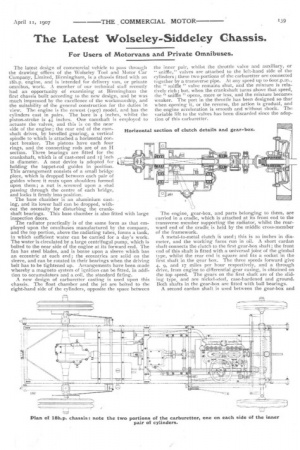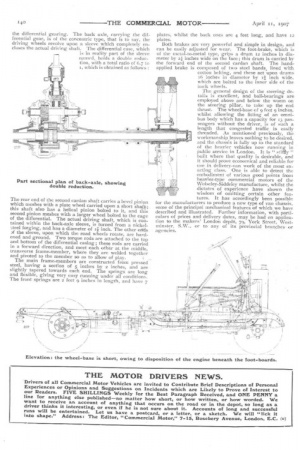The Latest Wolseley-Siddeley Chassis.
Page 7

Page 8

If you've noticed an error in this article please click here to report it so we can fix it.
For Users of Motorvans and Private Omnibuses.
The latest design of commercial vehicle to pass through the drawing offices of the Wolseley Tool and Motor Car Company, Limited, Birmingham, is a chassis fitted with an t8h.p. engine, and is intended for delivery van, or private omnibus, work. A member of our technical staff recently had an opportunity of examining at Birmingham the first chassis built according to the new design, and he was much impressed by the excellence of the workmanship, and the suitability of the general construction for the duties in view. The engine is the newest (1907) model, and has the cylinders cast in pairs. The bore is 4 inches, whilst the piston-stroke is 41 inches. One camshaft is employed to actuate the valves, and this is on the near side of the engine ; the rear end of the camshaft drives, by bevelled gearing, a vertical spindle to which is attached a horizontal contact breaker. The pistons have each four rings, and the connecting rods are of an H section. Three bearings are fitted for the crankshaft, which is of cast-steel and ft inch in diameter. A neat device is adopted for holding the tappet-rod guides in position. This arrangement consists of a small bridge piece, which is dropped between each pair of guides where it rests upon shoulders formed upon them; a nut is , screwed upon a stud passing through the centre of each bridge, and locks it firmly into position.
The base chamber is an aluminium casting, and its lower half can be dropped, without the necessity for disturbing the crankshaft bearings. This base chamber is also fitted with large inspection doors.
The radiator practically is of the same form as that employed upon the omnibuses manufactured by the company, and the top portion, above the radiating tubes, forms a tank, in which sufficient water can be carried for a day's work. The water is circulated by a large centrifugal pump, which is bolted to the near side of the engine at its forward end. The fan has steel blades, and is borne upon a sleeve which has an eccentric at each end ; the eccentrics are solid on the sleeve, and can be rotated in their bearings when the driving belt has to be tightened up. Arrangements have been made whereby a magneto system of ignition can be fitted, in addition to accumulators and a coil, the standard fitting.
A new design of carburetter casting is used upon this chassis. The float chamber and the jet are bolted to the right-hand side of the cylinders, opposite the space between Horizontal the inner pair, whilst the throttle valve and auxiliary, or " sniffle," valves are attached to the left-hand side of the cylinders ; these two portions of the carburetter are connected together by a transverse pipe. At any speed up to boor.p.m., the " sniffle " valve remains shut, and the mixture is relatively rich ; but, when the crankshaft turns above that speed, the " sniffle " opens, more or less, and the mixture becomes weaker. The port in the throttle has been designed so that when opening it, or the reverse, the action is gradual, and the engine acceleration is smooth and without shock. The variable lift to the valves has been discarded since the adoption of this carburetter.
The engine, gear-box, and parts belonging to them, are carried in a cradle, which is attached at its front end to the transverse member supporting the radiator, whilst the rearward end of the cradle. is held by the middle cross-member of the framework.
A metal-to-metal clutch is used ; this is to inches in diameter, and the working faces run in oil. A short cardan shaft connects the clutch to the first gear-box shaft ; the front end of this shaft is fitted with a universal joint of the gimbal type, whilst the rear end is square and fits a socket in the first shaft in the gear box. The three speeds forward give 4, 9, and 17 miles per hour respectively, and a through drive, from engine to differential gear casing, is obtained on the top speed. The gears on the first shaft are of the sliding type, and are nickel-steel, case-hardened and ground. Both shafts in the gear-box are fitted with ball bearings.
A second cardan shaft is used between the gear-box and
the differential gearing. The back axle, carrying the differential gear, is of the concentric type, that is to say, the driving wheels revolve upon a sleeve which completely encloses the actual driving shaft. The differential case, which is in reality part of the sleeve named, holds a double reduction, with a total ratio of 6.7 to t, which is obtained as follows : The rear end of the second cardan shaft carries a bevel pinion which meshes with a plate wheel carried upon a short shalt.; this shaft also has a helical pinion bolted to it, and this second pinion meshes with a larger wheel bolted to the cage of the differential. The actual driving shaft, which is contained within the back-axle sleeve, is turned from a nickelcteel forging, and has a diameter of ti inch. The other erlds .)f the sleeve, upon which the noad wheels rotate, are hardened and ground. Two torque rods are attached to the top and bottom of the differential casing ; these rods are carried in a forward direction, and meet each other at the middle, transverse frame-member, where they are welded together and pivoted to the member so as to allow of play. •
The main frame-members are constructed from pressed steel, having a section of 5 inches by 2 inches, and are slightly tapered towards each end. The springs are long and flexible, giving very easy running under all conditions. The front springs are 2 feet 9 inches in length, and have 7 plates, whilst the back ones are 4 feet long, and have 12 plates. Both brakes are very powerful and simple in design, and can be easily adjusted for wear. The foot-brake, which is of the metal-to-metal type, grips a drum 12 inches in diameter by 21 inches wide on the face ; this drum is carried by the forward end of the second cardan shaft. The handapplied brake is composed of two -steel bands, lined with cotton belting, and these act upon drums 16 inches in diameter by it inch wide, which are bolted to the inner side of the back wheels.
The general design of the steering details is excellent, and bail-bearings are employed above .and below the worm on the steering pillar, to take up the end thrust. The wheel-base of 9 feet 9 inches, whilst allowing the fitting of an omnibus body which has a capacity for 13 passengers without the driver, is of such a length that congested traffic is easily threaded. As mentioned previously, the workmanship leaves nothing to be desired, and the chassis is fully up to the standard of the heavier vehicles now running in public service in London. It is " stiffly " built where that quality is desirable, and it should prove economical and reliable for use in delivery-van work of the most exacting class. One is able to detect the embodiment of various good points from heavier-type commercial motors of the Wolseley-Siddeley manufacture, whilst the dictates of experience have shown the wisdom of omitting certain other features. It has accordingly been possible for the manufacturers to produce a new type of van chassis, some of the principal mechanical features of which we have described and illustrated. Further information, with particulars of prices and delivery dates, may be had on application to the makers London depot, 79, York Street, WeStminster, S.W., or to any of its provincial branches or agencies.






























































